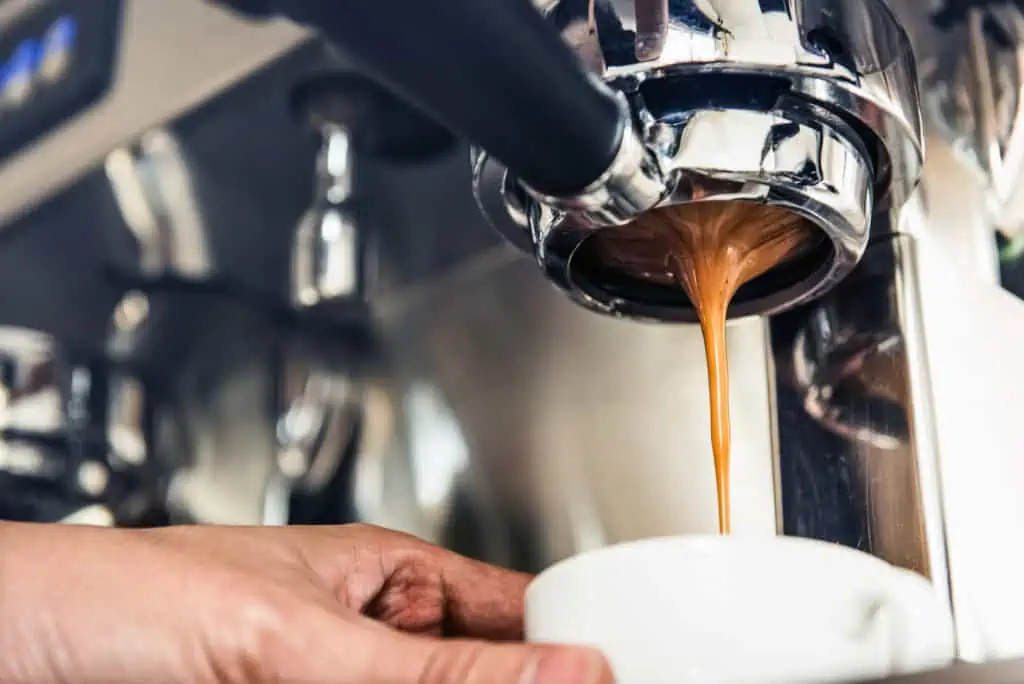
A closeup view of a barista pulling an espresso shot.
Each year, the Coffee Review team publishes an espresso report, for which we invite roasters to submit coffees on a specific theme. In typical years, we partner with an independent lab or roaster here in the San Francisco Bay Area and taste the espressos with at least one outside cupper and a barista or two dialing in and pulling shot after shot. But this year is certainly not typical. The COVID-19 pandemic forced us to skip last year’s espresso report altogether, and while we’re slowly getting back to in-person tasting in our own lab (after more than a year of remote work), we aren’t quite ready to collaborate more broadly. So, my colleague Jason Sarley and I pulled up our bootstraps and methodically evaluated in our own lab the 58 submissions we received — 29 from U.S. roasters and 29 from roasters in Taiwan. (The even split is a complete coincidence.)
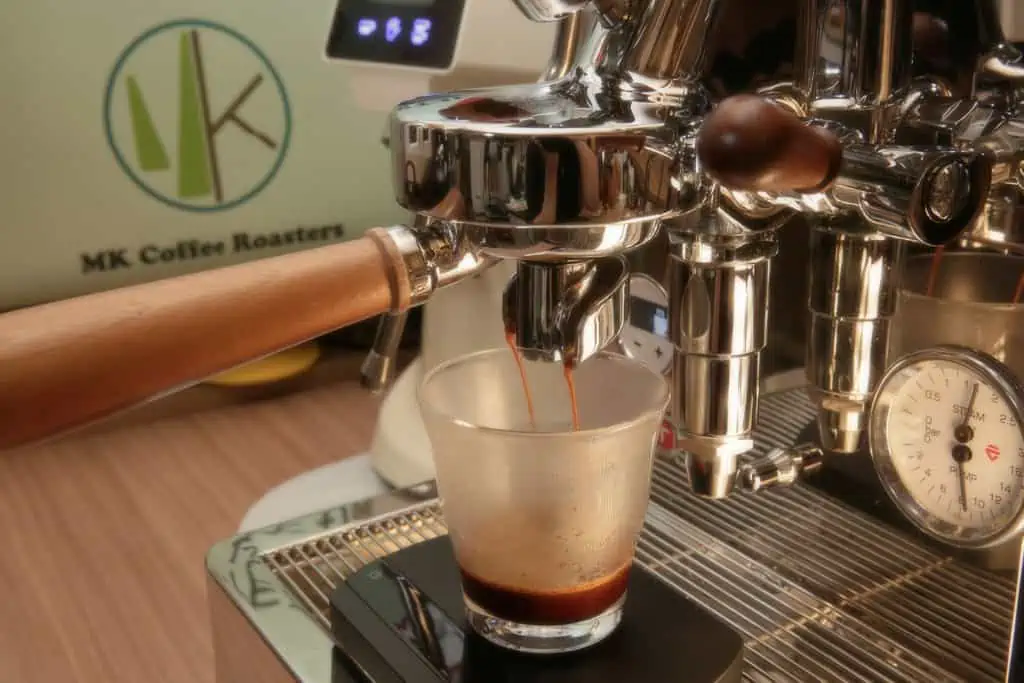
Pulling shots at MK Coffee Roasters in Taipei. Courtesy of MK Coffee.
Classic Darker-Roasted Espresso Blends
This year’s theme? Classic darker-roasted espresso blends. We review 12 coffees here, six from U.S. roasters and six from Taiwan, ranging in score from 91-96. The coffees from Taiwan averaged higher scores (for reasons that are not altogether clear), but rather than approach the report as an East/West battle of the shots, we decided to dig deeper into cultural questions about blend traditions, roasting styles, and what constitutes a “classic dark roast” for individual roasters.
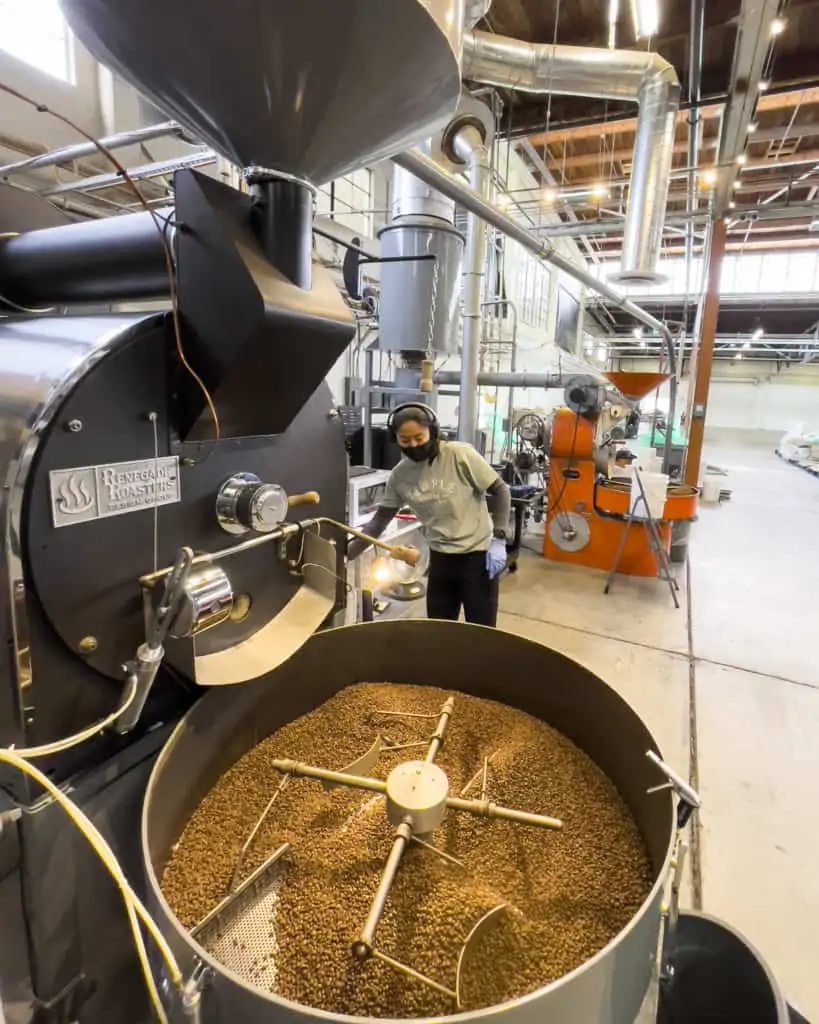
Roaster Camilla Yuan, of Temple Coffee in Sacramento. Courtesy of Temple Coffee.
But first, a note about our own sense of what “classic” and “dark roast” mean when it comes to espresso blends. When we decided to explore this topic, we agreed, as usual, not to let our preconceptions get in the way of simply assessing each coffee on its own merit. But, of course, we do have certain preconceptions. A case in point is how we define roast levels. We use an instrument called an Agtron spectrophotometer to objectively quantify the roast level of each coffee we review. (There are other devices for measuring roast level, but our M-Basic Agtron machine has been our reliable go-to for many years.) This instrument gives us numbers that are associated with the degree of development of the bean, or roast “color.” The lower the number, the darker and more developed the roast. We take two readings with our Agtron machine, one of the whole beans, and one of the beans after they have been ground. The ground reading is always higher in number (lighter in roast) than the whole-bean number because the interior of the bean is less roasted than the exterior. These two numbers appear in the “Agtron” field in our reviews. (For more information on Agtron numbers and roast color terminology, see our table of roast definitions.)
What Does “Darker-Roasted” Mean?
Reading Agtron numbers gives us a lot of information about how any given coffee was roasted, but in terms of defining level of “darkness,” which we were especially interested in for this report, we focused on the whole-bean number. Extremely dark-roasted coffees might have a whole-bean Agtron reading as low as 25-30, but frankly, these are almost always coffees whose original green character has been largely obliterated in the roasting process. At the opposite end of the scale, lighter-roasted coffees designed for drip brewing typically generate whole-bean Agtron numbers in the mid 50s to low 60s.
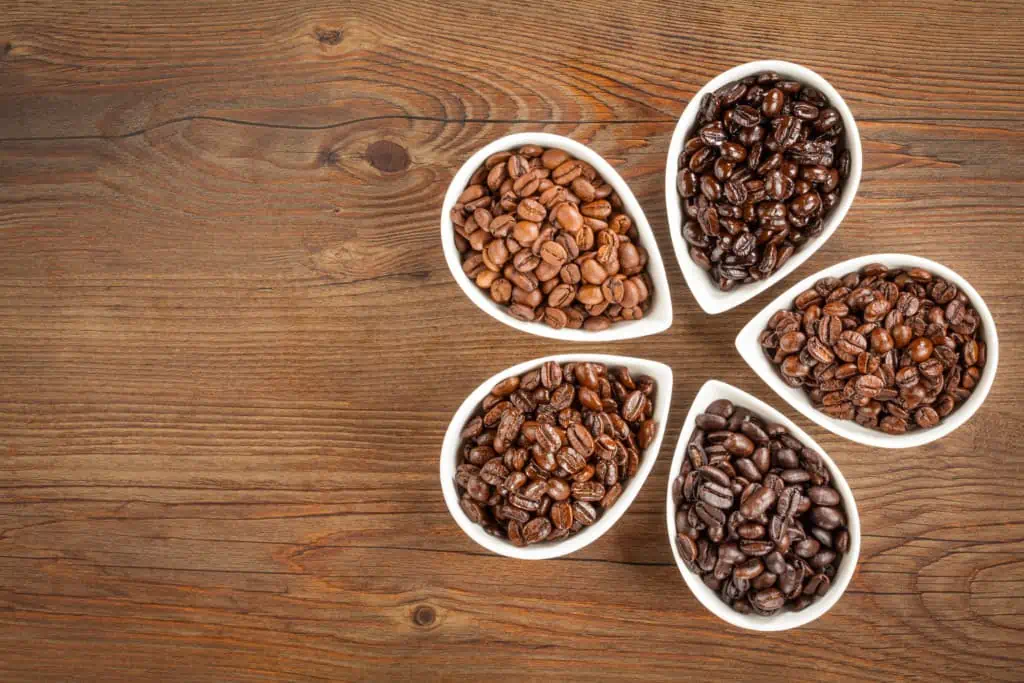
Roast colors. The three samples on the lower right represent three categories of roast development referenced in the report: light end of medium (directly on right, 3 o’clock), dark end of medium (lower left, around 8 o’clock), and dark (lower right, around 5 o’clock).
Our own sense of where “darker” begins on the whole-bean M-Basic roast-level spectrum is somewhere around Agtron 47 or 48. And this isn’t a random value we’ve assigned, but rather a number that we’ve identified, over many years, as the approximate point at which the impact of the roast begins to explicitly influence the sensory character of the bean. Some words we use to describe this impact are “roast-rounded” at the lighter end of the darker-roast spectrum, “roasty” at a darker, “smoky” at a still darker. These sensory shifts start to happen around “second crack” — when the heat from the roasting process begins to break down the cellular structure of the coffee bean and the oils start to emerge from its interior. This is, roughly speaking, somewhere around whole-bean Agtron numbers 45-50 for most coffees, so it stands to reason that this is the roast level at which we begin to detect the influence of singeing or scorching on flavor and structure, as well as the intensification of various aromatic consequences of sugar-browning, such as caramel, toast, nuts and chocolate.
But again, we wanted to let roasters determine what they consider to be “darker-roasted” espresso blends in their own diverse lexicons — this is, after all, a relative concept.
What Is A “Classic” Espresso Blend?
The “classic” category is equally subjective. We turned up essentially two responses to our call for “classic” darker-roasted espresso blends: Some roasters sent in their versions of Italian-American style espresso blends, what many espresso-lovers think of as “classic” espresso: bold, darker-roasted, chocolaty-sweet blends that maintain their presence well in milk. Others submitted what might be considered “classic” third-wave espressos, which tend to be lighter-roasted and more fruit-driven. See below for high-scoring roasters’ thoughts on what “classic” means to lovers of their coffees.
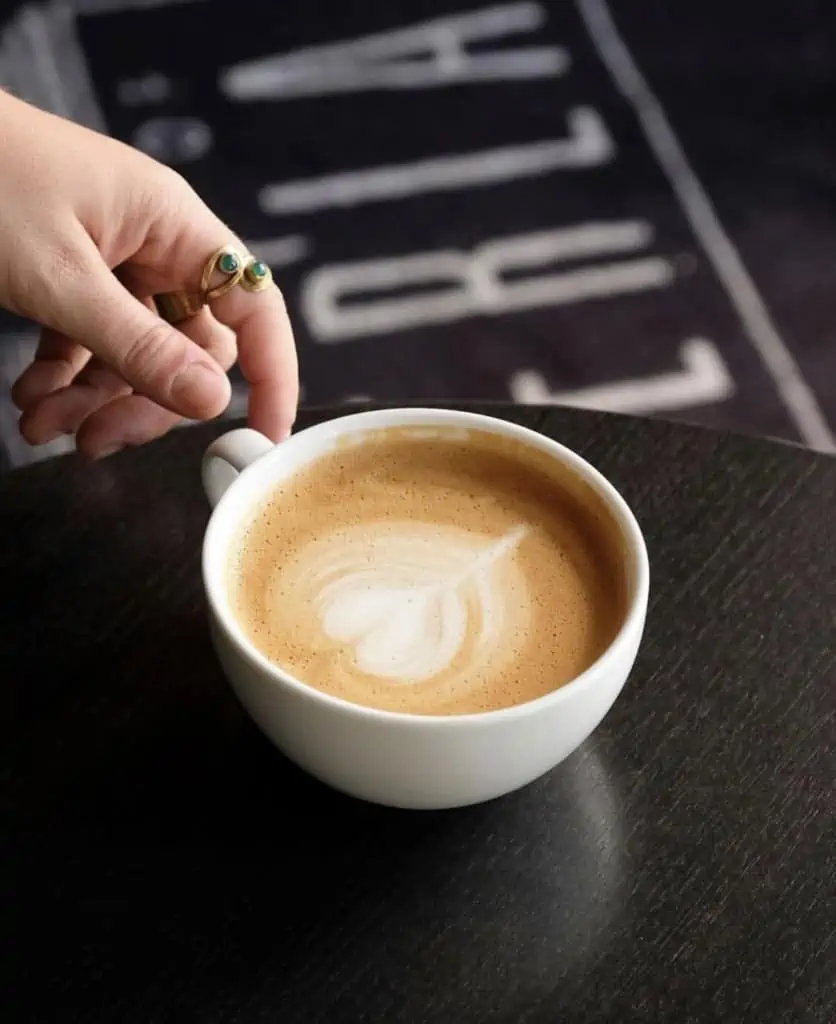
Latte art at Per’La Specialty Roasters in Miami, Florida. Courtesy of Per’La.
Milk, Glorious Milk
Milk figures prominently in the narrative of espresso. When we test espressos, we evaluate them in the following categories: aroma, body, flavor, aftertaste, and with milk. Our basic recipe, which we use as a way of standardizing our evaluation process, is 18 grams of ground coffee in, 32 grams of brewed coffee out, over approximately 26 seconds (not counting pre-infusion), with an extraction temperature of roughly 198°F. Our milk of choice is Clover organic whole milk, a Bay Area brand. For the “with milk” category we test a fresh shot of the sample coffee combined with three parts milk that has been heated with the steam wand but not frothed.
We test all espressos, at any roast level, with milk, but the milk category is especially important with darker-roasted espressos. Per’la co-founder Paul Massard, whose Espresso Fino is featured this month, says the milk contribution is paramount for many of his customers: “We have found that, although specialty coffee puts a lot of emphasis on the espresso shot, most consumers are going to have it with milk as a cortado, cappuccino or [caffè] latte.” Many of the other roasters we spoke with echoed this sentiment, in particular the Taiwan-based roasters, who all agreed that the milk shot was the most essential aspect of nailing a good darker-roasted espresso blend, given that the vast majority of their customers take their espresso in a with-milk format. Unlike countries that have a strong straight-espresso culture, like Italy and Australia, both the U.S. and Taiwan (the two regions where all of the submissions for this were report were roasted) lean more toward milk-based espresso drinks.
Of course, as we know, many coffee bars offer all manner of milk substitutes, a fascinating subject, but one that we don’t have the bandwidth to address here.
Art of Darkness
Surprisingly to us, several of the darkest-roasted blends we tested earned some of this report’s highest scores. We were surprised because the high-end specialty coffees we usually feature skew lighter in roast (see below for more details). But there are some roasters out there who’ve perfected the art of darkness, if you will.
Top of mind is Simon Hsieh, of Taiwan’s Simon Hsieh Aroma Roast Coffees. As a green importer and a roaster, Hsieh is widely admired for his mastery of dark-roasting practices. And he has unabashedly embraced a darker style across his entire line of coffees, all designed for espresso. His “Bull Demon King” blend submitted for this report earned 96 points, knocking it out of the park with rich chocolate notes, smoky depth, and lyrically sweet florality — the milk shot earned a category score of 10 with its decadent perfection: layers of undulating chocolate, wisteria and scorched sugarcane notes lasting far into the long finish.
Of this coffee, Hsieh says, “Dark roasts require high-quality green coffees to withstand the extra high temperatures and significant flavors to survive. A great dark roast blend is sweet but not so bitter, low-toned yet lingering and comforting.”
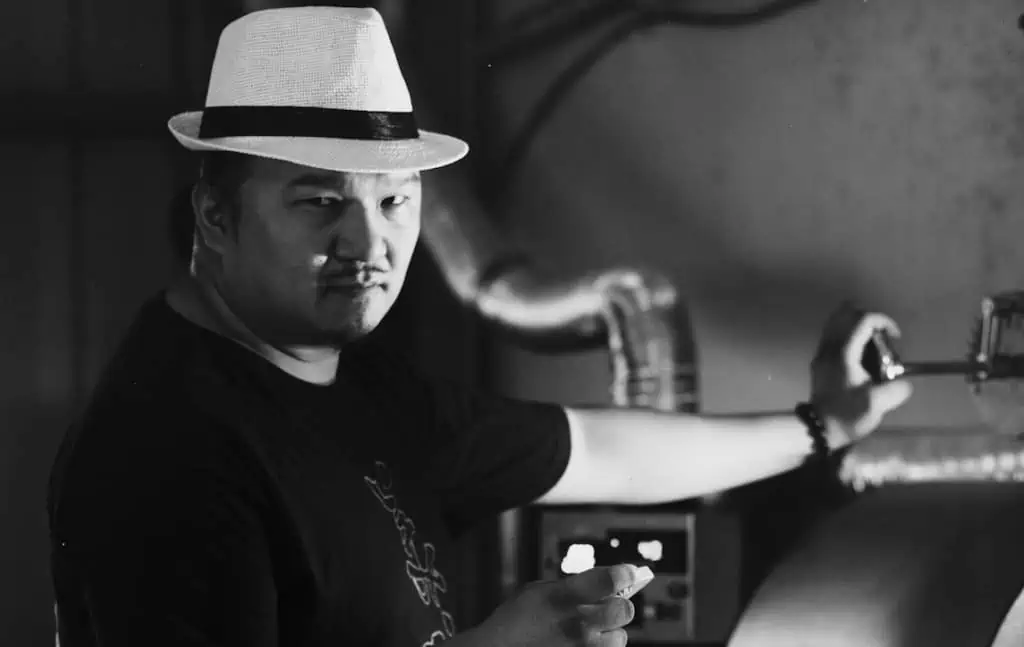
Simon Hsieh, of Taiwan-based Simon Hsieh Aroma Roast Coffees, has dedicated his coffee career to refining the art of dark-roasting. Courtesy of Simon Hsieh.
What makes it “classic”? Hsieh says it’s all about the basic blend logic: 3/4 clean, washed coffees plus 1/4 natural-processed coffees. He feels that this ratio enhances body, crema and structure, while not letting natural coffee character dominate in the demitasse. He also recommends a spoonful of sugar stirred into the shot, as many Italians do, or a piece of bittersweet chocolate alongside. This is an old-school practice that he would love to see return in contemporary cafés.
Hsieh’s Bull Demon King has a whole-bean Agtron of 35. We review two additional coffees (both from Taiwan), both rated 94, with whole-bean Agtrons of 36 and 39. All three occupy a roast range at the cusp of what we identify as “medium dark” and “dark.” Coffee Please’s “Chocolate Lover’s Espresso” (94) is aptly named with its throughline of chocolate fudge alongside pistachio, gardenia, scorched mesquite and molasses notes. And MK Coffee Roasters’ Classic MK Blend (94) is elegantly harmonious with delicate chocolate and warm, dusky spice tones throughout.
It’s important to note that we tested coffees with still lower Agtron readings than the three samples noted above, but these even darker samples (whole-bean Agtron readings below 35) generally tended to be sharply bittersweet and burnt.
Best of Both Worlds: Medium- to Medium-Dark Roasts
Coffees roasted toward the dark end of medium, which we define as having whole-bean Agtrons in the high 40s, may or may not display detectable roast character, but if done well, always preserve the fruit and floral notes inherent in the green coffee. We review six such coffees here, and they each, whether low-toned or high-toned, manage to present an expressive range of sensory experiences.
Paradise Roasters’ Espresso Nuevo (93) was developed 15 years ago by Paradise owner Miguel Meza as a follow-up to his Italian-style Espresso Classico. Miguel calls it his “new-wave, Seattle-style blend.” Now the company’s bestselling blend, Espresso Nuevo “was designed for larger milk-based drinks for wholesale clients,” says Meza. He adds, “In recent year’s iterations, we’ve used aged coffees that we feel help to create a heavier mouthfeel and push through milk well without needing to roast too dark and increase bitterness or lose other desirable flavors. While this blends construction has evolved over time, it has always remained a darker-roast style with excellent performance in milk beverages as its focus.”
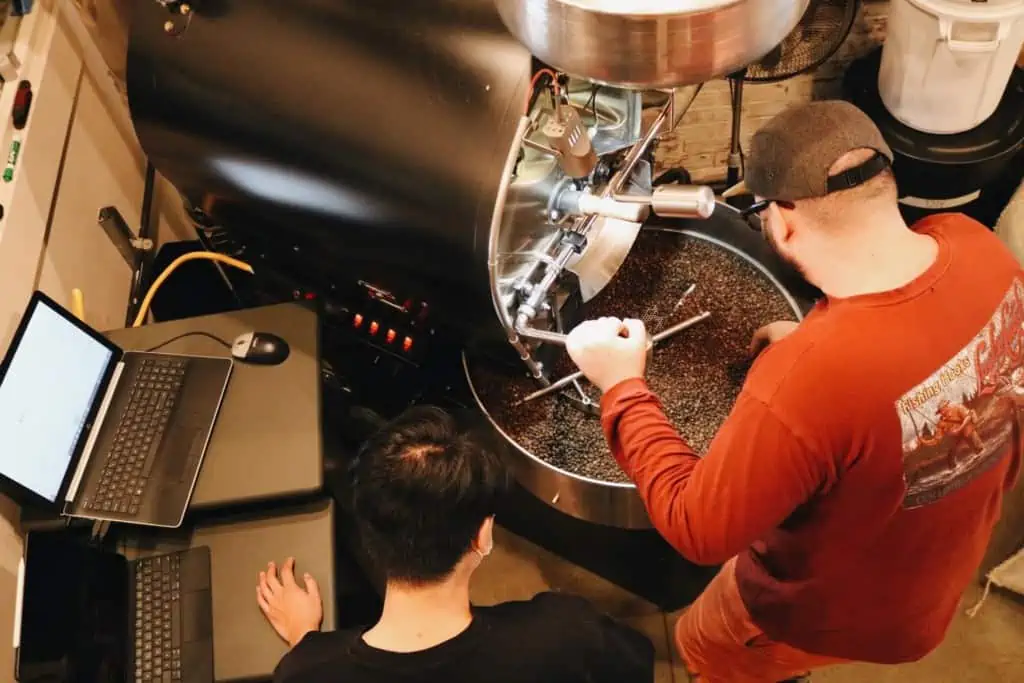
In the roastery at Peach Coffee in Johns Creek, Georgia. Courtesy of Peach Coffee Roasters.
Coming in with scores of 91 and 92 were blends from four U.S. roasters and one based in Taiwan: Peach Coffee’s Red Clay (92); Temple Coffee’s Dharma Blend (92); Toca Coffee’s Amasia Blend (91); Durango Coffee’s Durango Espresso (91); and Taiwan-based Tribo Coffee’s Campfire Blend (91). (Click on the review link at the end of the report for full details.)
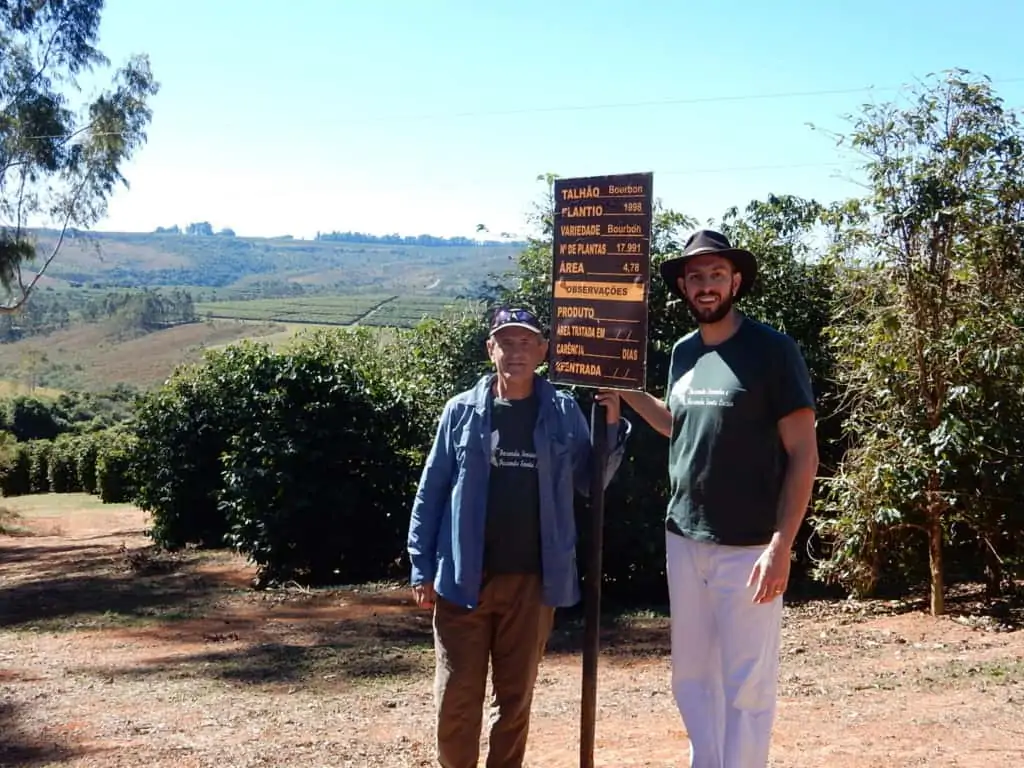
Carl Rand, of Durango Coffee, and farmer Ronaldo Azzi, in Minas Gerais, Brazil, where a key component of the Durango Espresso blend is sourced. Courtesy of Durango Coffee.
Happy Medium: Lighter But Developed
The lightest-roasted coffees we considered for the theme of “darker-roasted” displayed whole-bean Agtrons in the low 50s, putting them at the light end of medium. Why did we allow such uncompromising medium roasts into a conversation about “darker-roasted” espresso blends? Because the trend in specialty coffee for some time now is to roast lighter, whether for batch brew, pourover, or espresso applications. Many of the espressos we regularly receive for blind review display Agtrons in the mid-50s. (These numbers are a slightly darker departure from third-wave roasters’ average Agtrons for non-espresso submissions, which hover in the high 50s to low 60s.) It seemed only fair to allow “darker” its own relativity, given that we test many high-performing espressos with Agtron readings in the medium or medium-light range.
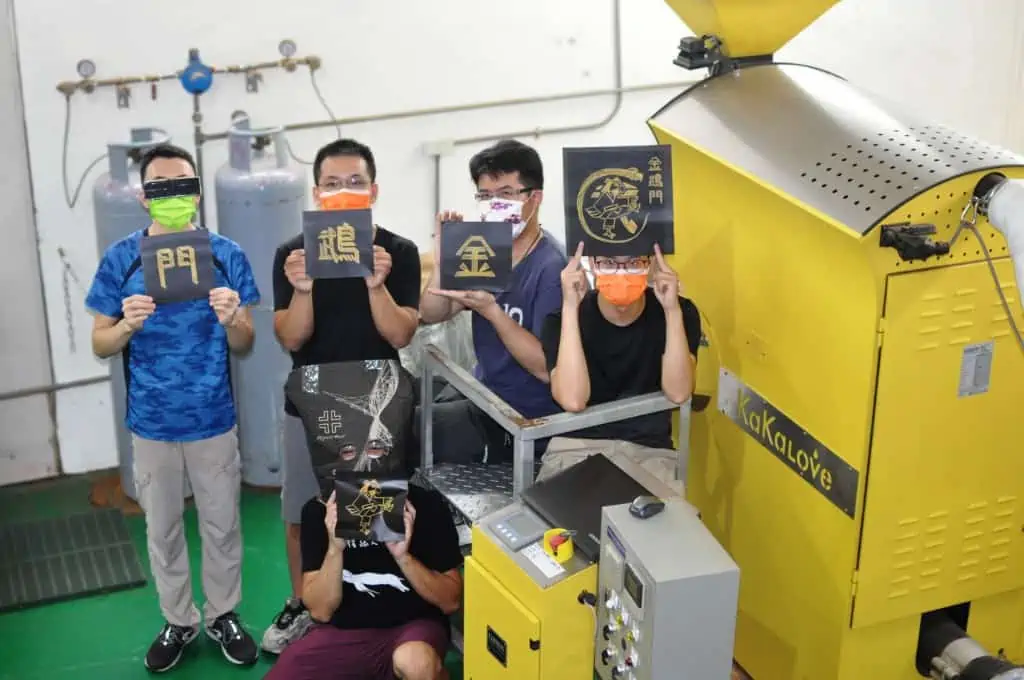
Kakalove’s staff celebrating their Golden Parrot Espresso Blend. Courtesy of Kakalove Cafe.
The highest-scoring lighter roast we tested for this report was Taiwan-based Kakalove Café’s Golden Parrot Blend (95), a blend of washed Guatemala, washed Colombia, and natural Ethiopia that is especially fruit- and floral-driven. Kakalove owner Caesar Tu says of his Golden Parrot Blend, “The roast level is not as dark as a traditional Italian espresso. I would like to preserve berry tones from the natural Ethiopia and give the roast more development time to increase its sweetness. It will suit most people in the straight shot or as cappuccino. I think it’s ‘classic’ in terms of its friendliness as a daily coffee.”
Two other espresso blends whose Agtron values landed on the light end of the medium range were Queen Coffee’s submission (94), which highlights citrus and pipe tobacco notes, and Per’La’s Espresso Fino (92), whose straight shot displays dried apricot, cocoa powder, fresh-cut cedar, almond and magnolia.
Massard, of Per’La, acknowledges that “not many coffee consumers appreciate an espresso shot that tastes like hot grapefruit juice,” suggesting that a coffee can be brought to a medium roast that preserves fruit without shocking the palate with high acidity.
If there’s a takeaway here, perhaps it’s that tactful roasting can preserve a fairly wide range of sensory nuance in espressos even at “darker” roast levels, while medium-roasted espressos can maintain their fruit and florals without being sharply acidic. And, of course, that in today’s world of espresso, “classic” is in the eye of the beholder.










